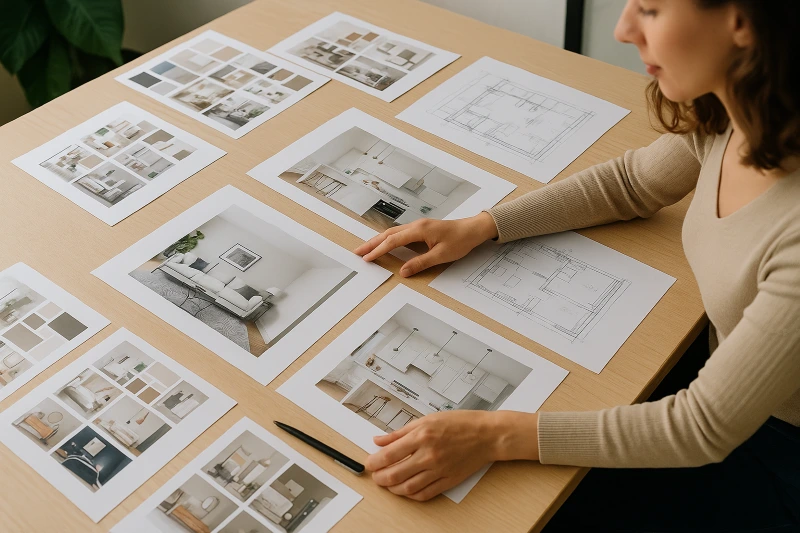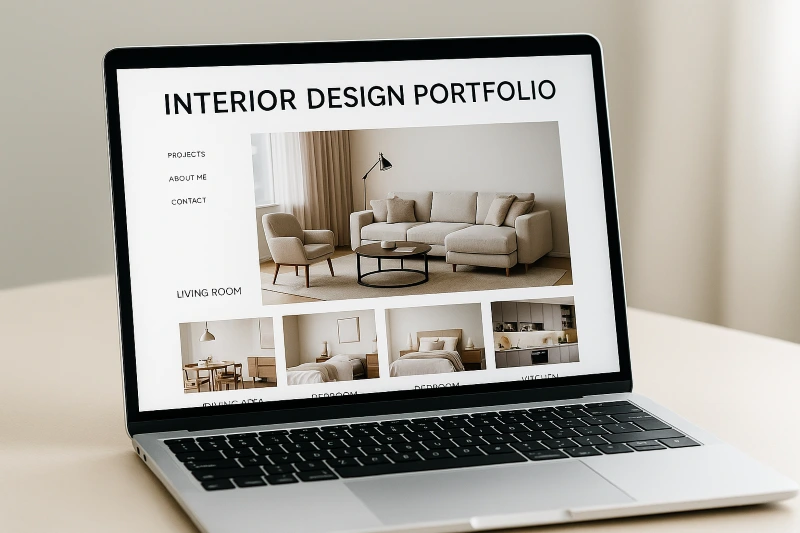
Your portfolio is more than a slideshow of past work — it’s your personal brand, your design voice, and your best chance to connect with clients or employers before you even speak a word. Whether you’re applying for a dream job, pitching your freelance services, or just getting started in the field, how you present your work matters.
In this guide, we’ll walk through how to build a portfolio that not only looks great but feels authentic to who you are — and helps you stand out in a sea of designers.
At its core, an interior design portfolio is a curated collection of your work, but it should do more than just showcase pretty pictures. A great portfolio tells a story: who you are as a designer, how you think, and what kind of experience you create for clients.
Your portfolio can be digital, printed, or both. Digital portfolios are easier to share and update, while printed ones can make a strong impression during interviews or client meetings.
It’s tempting to load your portfolio with every project you’ve ever done — but more isn’t always better. Instead, focus on a handful of strong, well-documented projects. Include not just the final results, but also your concept development, moodboards, sketches, and how you solved specific challenges.
Every strong interior design portfolio starts with clear organization and intent. A well-prepared portfolio typically includes a thoughtful introduction, concise project summaries, professional photography, and design development visuals like sketches, floor plans, and concept boards. These aren’t just extras — they give viewers a window into your process and critical thinking. As highlighted in industry-recognized interior design portfolio best practices, even student portfolios benefit from showcasing academic work that demonstrates design development and visual storytelling.

Begin with a clean, branded cover page that includes your name and title (e.g., “Interior Designer” or “Residential Specialist”). Follow that with a short bio or design statement — something that gives people a feel for your aesthetic, influences, and process.
Then, organize your portfolio into sections, with each project getting its own spotlight.
For each featured project, include:
Don’t forget to include your role if it was a team project. Clarity and honesty go a long way.
Think of your portfolio as an extension of your interior design philosophy. Just like you wouldn’t decorate every space the same way, your portfolio shouldn’t feel generic or disconnected from your style. If your work is vibrant, layered, and expressive, your portfolio should reflect that energy. If your designs lean minimalist and serene, let that mood guide your layout choices too.
Use typefaces, colors, and white space with the same care you’d apply to a room’s finishes and lighting. You want your portfolio to be visually cohesive, easy to navigate, and pleasant to explore — not just a folder of project images. When done right, your portfolio becomes a branded experience, not just a presentation.
And yes, professionalism matters, but that doesn’t mean stripping away your personality. A little creative flair (a handwritten font, a pop of unexpected color, or a unique layout twist) can go a long way in making your portfolio feel like you.
Not every project — or audience — wants the same vibe. That’s why it’s smart to tailor your portfolio depending on who you’re trying to reach. A luxury residential client might want to see warmth, emotion, and detail. A commercial office firm may look for clean layouts, technical polish, and a clear process. One size doesn’t always fit all.
Create a couple of variations: one for job applications, one for freelance pitches, and maybe even one for specific design sectors (like hospitality vs. retail). That way, you’re always presenting the most relevant version of your work.
By customizing your portfolio’s tone, visuals, and project selection, you’re showing potential clients or employers that you understand their world — and that you’ve designed with their needs in mind. That level of thoughtfulness stands out.
Yes, people want to see what the space looked like in the end. But they also want to know how you got there. That means sharing early sketches, design challenges, client feedback, anything that helps paint a fuller picture of your creative process.
Choose your best 4–6 projects and present them clearly. A smaller portfolio that tells a strong, consistent story will always win over a bloated one that feels unfocused.
Suppose you can show that you’re just as comfortable creating cozy residential spaces as you are reviewing floor plans or specifying lighting, even better. Let your range shine, but keep the overall flow cohesive.
There’s no one-size-fits-all when it comes to portfolio formats — the best choice depends on your goals and your audience. That said, digital PDFs remain one of the most effective and professional options for job applications, client proposals, and quick sharing. They’re easy to email, view offline, and control in terms of layout and presentation.
But if you want to boost visibility or build your personal brand, think bigger. A personal website or portfolio platform like Behance gives you space to tell your story more fully and keeps your work accessible to anyone, anytime. A simple portfolio site (even a single-page one) shows that you take your career seriously and can make you stand out in a crowded field.
And don’t underestimate the power of social platforms like Instagram. While it’s not a substitute for a formal portfolio, it’s a fantastic way to share process shots, finished work, and behind-the-scenes moments. It helps followers connect with you as a person, not just a professional, which is especially valuable for freelancers or designers building a client-facing brand.
Pro tip: No matter where you showcase your portfolio, make sure it’s mobile-friendly. A huge portion of your audience — whether it’s a hiring manager or potential client — will be viewing your work on their phone. If your layouts don’t scale or the images load slowly, it could cost you the opportunity.
Your portfolio isn’t meant to be a “set it and forget it” kind of thing. It should grow with you, reflecting your evolving style, skillset, and focus as a designer. Think of it as a living document, not just a scrapbook of past wins.
Try to update your portfolio every few months, even if the changes are small. Add a new project you’re proud of. Rewrite your intro to better reflect where you are now. Swap out older work that no longer aligns with the types of projects you want to attract.
It’s also a good idea to track what gets the best responses — whether it’s specific project types, visual styles, or platforms that bring in more leads or interview invites. Let that data help shape what you showcase next.
And most importantly? Make sure your portfolio still feels like you. As your career matures, so will your voice, taste, and goals. Let your portfolio reflect that growth.
While your portfolio remains your core presentation tool, many interior designers now also incorporate remote collaboration into their services. Working with clients across locations has become a common part of modern design workflows. For a deeper look at how remote design services are shaping the industry, explore this guide on remote design services.

Building a great portfolio takes time, but it’s one of the most worthwhile investments you’ll make as a designer. It’s your chance to express who you are, showcase your talent, and build trust with future collaborators.
So don’t just fill pages — craft a narrative. Curate, reflect, and present your work in a way that feels true to you. Because at the end of the day, it’s not just about what you’ve done — it’s about where you’re headed, and how you want to be seen.
About the Author
With a focus on creative presentation and professional growth, UpTalent explores how to build an interior design portfolio that reflects your style, communicates your process, and helps you stand out in a competitive field.
Expertise:
Explore these related articles to dive deeper into the topic and discover more insights.

Customer Support Outsourcing: A Smart Solution for Small Businesses

The Role of a Partnership Manager in Building Strong Business Relationships

Data Entry vs Data Analyst: Which One Drives Better Business Insights?